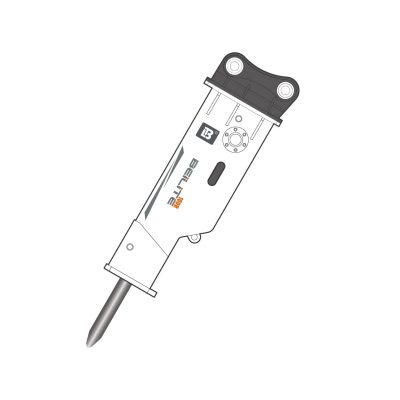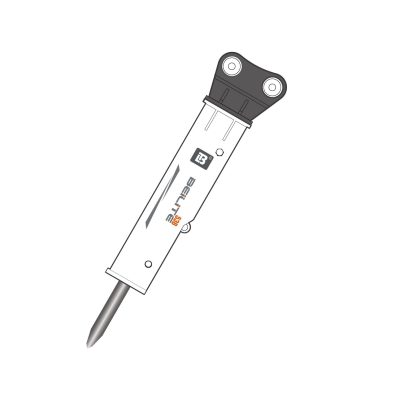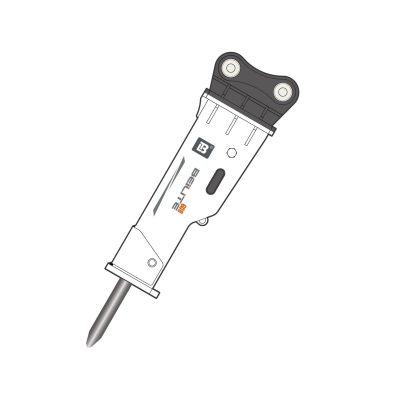What Are Hydraulic Breakers for Medium Excavators?
Hydraulic breakers for medium excavators use hydraulic power to break hard materials like rock, concrete, and asphalt. Construction teams often use these breakers on job sites where they need high-impact performance. Medium excavators typically weigh between 10 and 20 tons, making them ideal carriers for mid-range hydraulic breakers.

Operators use these attachments to complete demanding jobs with speed and precision. Project managers select breakers based on tool diameter, energy class, and impact rate to match specific site demands. Users depend on these tools for road construction, demolition, and trenching.
Key Applications in Modern Construction
Contractors regularly use hydraulic breakers for medium excavators across multiple industries. These include:
- Demolition: Breaking reinforced concrete in buildings or bridges.
- Quarrying: Fragmenting hard rock without blasting.
- Utility Work: Digging trenches for pipes or cables.
- Road Repair: Removing asphalt or concrete surfaces.
These breakers offer consistent impact force and save time compared to manual or traditional methods. Their mobility allows users to cover large work zones while maintaining precision.
Components and How They Work
Each breaker features core components that work together to generate impact:
- Hydraulic cylinder: Transfers pressurized oil into mechanical force.
- Piston: Delivers striking force directly to the working tool.
- Tool bit (chisel or moil): Strikes the material to break it.
- Accumulateur: Maintains pressure for consistent performance.
Operators control these breakers using the excavator’s auxiliary hydraulic system. By adjusting flow and pressure, they control striking power and frequency.
Choosing the Right Size for Your Excavator
Selecting a compatible breaker ensures safety, efficiency, and productivity. Here’s how users match a breaker with a machine:
- Carrier weight compatibility: Medium excavators between 10–20 tons pair best with breakers ranging from 500 to 2000 kg.
- Hydraulic flow range: Breaker flow requirements must match the excavator’s hydraulic system.
- Tool diameter and energy class: These specs determine breaking capacity and impact strength.
Using an oversized breaker can damage the excavator’s boom or hydraulic system. An undersized tool reduces breaking efficiency.
Energy Output and Impact Rate
Performance depends on two main factors:
- Impact energy (joules): Measures force per strike.
- Blow rate (BPM): Shows how many times per minute the piston strikes.
Medium-class breakers usually provide between 1000–4000 joules per strike at rates between 400–1000 BPM. Operators adjust settings to balance speed and power depending on the material.
Tool Options and Their Functions
Users select specific tools based on job requirements:
- Moil point: Breaks general-purpose concrete and rock.
- Chisel: Ideal for cutting or trenching.
- Blunt tool: Best for breaking large, flat surfaces.
Each attachment connects to the breaker via a locking pin and works under the same hydraulic pressure.
Compatibility with Medium Excavators
Manufacturers design breakers with different mounting options. Users must check bracket dimensions, pin diameter, and hydraulic hose connections. Compatibility ensures proper alignment and consistent force transmission.
Contractors often consult OEM specifications before attaching a breaker. Doing so reduces wear on both the excavator and the breaker, extending equipment life.
Features That Improve Productivity
Breakers for medium excavators now include features that boost performance and operator comfort:
- Noise-reduction housing: Reduces vibration and sound.
- Anti-blank firing systems: Prevents damage from firing with no resistance.
- Auto-greasing systems: Keeps internal parts lubricated without manual intervention.
- Energy recovery systems: Recycle recoil energy to increase impact.
These features help users complete tasks faster with lower fuel consumption and minimal wear.
Maintenance Tips to Extend Service Life
Daily maintenance reduces failure risks. Operators perform these checks:
- Visual inspection: Look for leaks, cracks, or wear.
- Lubrication: Apply grease to the tool bushings before each shift.
- Check hydraulic hoses: Ensure connections are tight and free from damage.
- Inspect tool retainers: Verify they are secure and undamaged.
Technicians should monitor nitrogen gas levels in the accumulator and replace worn bushings or pistons regularly.
Cost Considerations and Total Value
Pricing depends on several factors:
- Breaker size and impact power.
- Included technology (e.g., auto-lube systems).
- Brand reputation and after-sales support.
While high-quality hydraulic breakers for medium excavators cost more upfront, they often last longer and require fewer repairs. Buyers should evaluate total cost of ownership, not just purchase price.
Safety Guidelines for Operators
To prevent accidents, crews follow these rules:
- Wear PPE including ear protection, gloves, and eye shields.
- Keep bystanders away from the impact zone.
- Use proper tool for the material being broken.
- Never operate with a loose or damaged tool retainer.
Following these steps helps operators avoid injuries and equipment failures.
Common Questions and Answers
What size breaker fits a 15-ton excavator?
A 15-ton excavator usually pairs with a breaker weighing between 1000–1500 kg, delivering up to 3000 joules per strike. Always verify hydraulic flow and tool diameter before selection.
How often should I grease a hydraulic breaker?
Operators should grease the tool every 2–4 hours during operation. Some models include auto-greasing systems that handle this automatically.
Can I use the same breaker on different excavators?
Yes, if those excavators fall within the same carrier class and share similar hydraulic specifications. Users may need to change mounting brackets and hose connections.
What happens if I use the wrong tool bit?
The wrong tool can cause faster wear, reduced efficiency, and even internal damage. Always match the bit to the material and task.
How Beilite Supports Your Projects
Beilite designs and manufactures hydraulic breakers for medium excavators that meet tough jobsite demands. Our models provide high impact force, efficient energy recovery, and noise-reducing housings.
We support clients with:
- A wide range of tool bit options.
- Fast delivery of spare parts.
- Dedicated technical guidance.
- Reliable after-sales service.
Contractors choose Beilite products for their durable build and stable performance under pressure. We design each model for long-term use in harsh environments.
Final Thoughts on Selecting a Breaker
Project leaders must consider excavator size, hydraulic compatibility, and application type when choosing a breaker. The right match ensures productivity, safety, and long-term performance.
Operators should follow maintenance routines, safety checks, and correct tool selection for every task. These steps improve uptime and lower total costs.
Beilite remains ready to support your team with robust, field-tested solutions. Our experts can help you choose the right hydraulic breakers for medium excavators based on your exact needs.
Ready to Improve Site Efficiency?
Contact Beilite today to speak with our team. We’ll help you select the best breaker for your medium excavator and support you throughout the product’s lifespan. Let us help you power through your next challenge.









